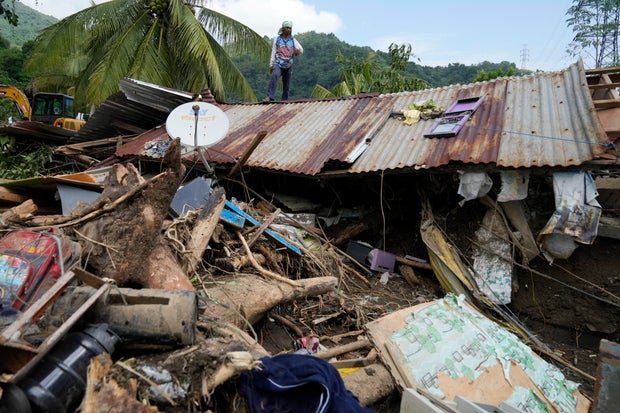The number of people killed and missing in severe flooding and landslides caused by Tropical Storm Trami in the Philippines has reached nearly 130 and the president said on Saturday that many areas remained isolated with people in need of help.
Trami ripped through the northwestern Philippines on Friday, leaving at least 85 people dead and 41 others missing in one of the Southeast Asian archipelago’s biggest and most destructive storms so far this year, the government’s disaster management agency said. The death toll is expected to rise due to reports from isolated areas.
Dozens of police, firefighters and other emergency personnel, supported by three backhoes and sniffer dogs, dug up one of the two missing villagers in the Talisay lake in Batangas province on Saturday.
Aaron Favila / AP
A father, who was waiting for news about his missing 14-year-old daughter, cried as rescuers placed her body in a black body bag. Bewildered, he followed a police officer, who carried a body bag down a muddy village alley to a police car as a tearful resident approached him to express his sympathy.
The man said he was sure it was his daughter, but authorities needed to check to confirm the identity of the resident dug up in the mound.
In a basketball gym near the center of the city, more than a dozen white coffins were laid side by side, carrying the remains found in a pile of mud, rocks and fallen trees on Thursday afternoon down a steep slope at the top of the forest in Sampaloc Village Talisay.
President Ferdinand Marcos, who inspected other areas southeast of Manila, said the unusually large volume of rain dumped by the storm – including in some areas that experienced one to two months of rain in just 24 hours – was controlling flooding. in the province lashed by Trami.
“There is a lot of water,” Marcos told reporters.
“We are not done with the rescue work,” he said. “Our problem here is that there are still many areas that remain flooded and cannot be accessed even by large trucks.”
His administration, Marcos said, will plan to start a major flood control project that can meet the unprecedented threat of climate change.
Aaron Favila / AP
More than 5 million people are in the storm’s path, including nearly half a million who would normally flee to more than 6,300 emergency shelters in several provinces, government agencies said.
At an emergency Cabinet meeting, Marcos expressed concern over reports by government forecasters that the typhoon – the 11th to hit the Philippines this year – could make a U-turn next week as it is pushed again by high-pressure winds in the South China Sea. .
The storm is forecast to hit Vietnam by the end of the week if it doesn’t deviate.
The Philippine government closed schools and government offices for a third day on Friday to keep millions of people safe on the main northern island of Luzon. Inter-island ferry services were also suspended, to the tune of thousands.
The weather cleared in many areas on Saturday, allowing for cleanup work in most areas.
Every year, about 20 storms and typhoons hit the Philippines, a Southeast Asian archipelago located between the Pacific Ocean and the South China Sea. In 2013, Typhoon Haiyanone of the strongest tropical cyclones on record, leaving more than 7,300 people dead or missing and destroying entire villages.
In 2015, a massive landslide buried Dozens of houses near the mountains of the central Philippines, killing at least 15 people and sending rescuers scrambling to find survivors after several text messages asking for help.





